Cloud pricing models vary widely, and it is easy to overspend if you select a model that is a poor fit for your application. So what’s the best model to help you manage cloud spend?
The ideal model will vary by your needs, but in all cases you should try to ensure your paid cloud resources are optimized to match your actual usage. This means organizations should carefully evaluate their usage patterns, workloads, and growth predictions before selecting a pricing model.
In this article, you’ll learn more about cloud cost models, including common challenges and best practices to consider when selecting a model. We’ll also look at the future of cloud cost models and how Spinnaker Support can help you improve performance and reduce costs, at any point in your cloud computing journey.
What are cloud cost models?
Cloud cost models refer to the pricing structures that cloud service providers use to bill customers for their services. These models establish how providers charge users for the particular cloud resources and services they use.
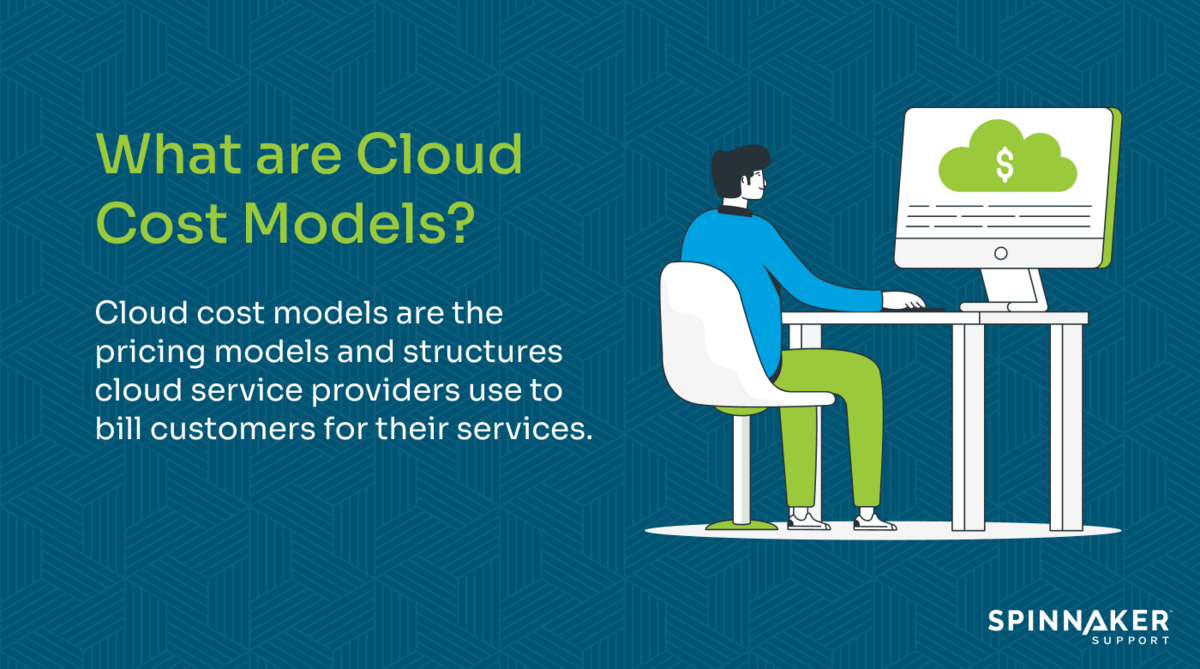
Cloud computing promises greater efficiency and flexibility than legacy infrastructures, which in theory should help lower IT costs.
Yet, most companies struggle to estimate their cloud spend accurately, especially when facing the wide variety of cloud cost models offered by cloud providers. Therefore understanding the nuances of cloud cost models is key to successfully managing your cloud costs.
What are the different types of cloud cost models?
The main pricing models are pay-as-you-go, reserved instances, fixed subscriptions, and spot instances. We’ll explore each of them below.
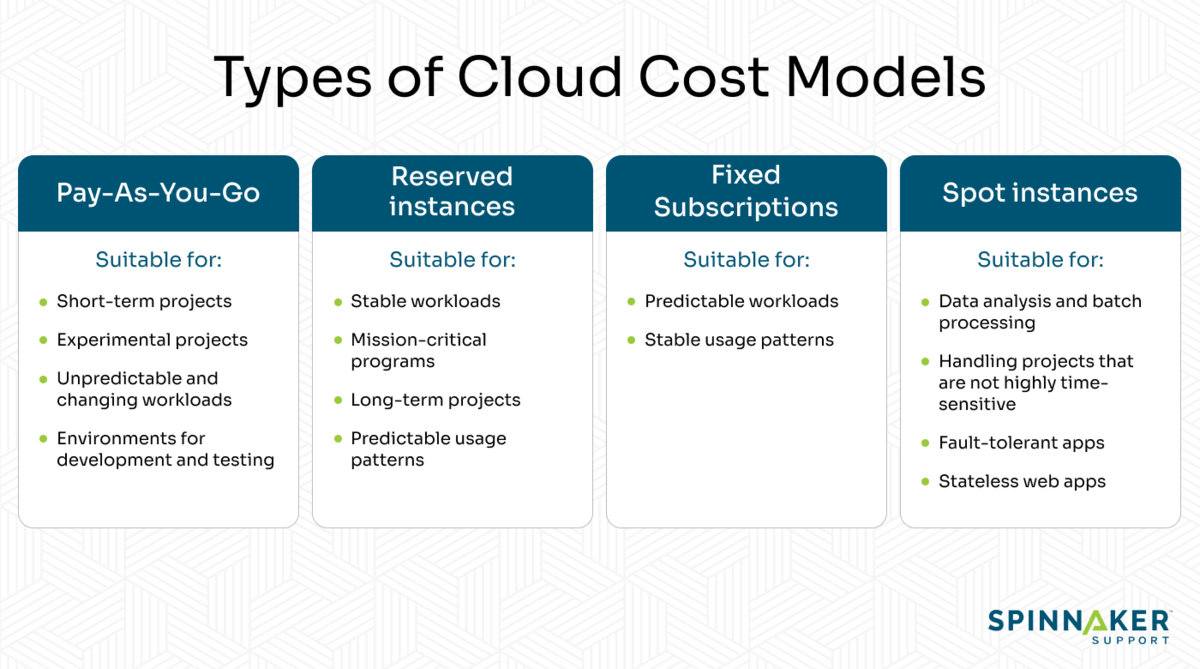
Pay-As-You-Go
In the pay-as-you-go model, also known as on-demand pricing, you pay for computing resources based on usage. This model is adaptable because it allows you to adjust your resources to meet fluctuating demand.
The pay-as-you-go model suits short-term projects, experimental projects, and unpredictable and changing workloads. You can also use this model to set up environments for development and testing.
One of the best approaches for cost management when using pay-as-you-go is to employ monitoring tools. Monitoring tools and logging mechanisms provide insights into cloud usage and performance.
Continuous monitoring of your usage and billings allows you to scale down under-used resources to save costs. However, since you may have to scale up during peak times, your cloud costs can quickly increase and even exceed your budget.
Reserved instances
With reserved instances, businesses can reserve cloud resources for a selected period, usually two or three years. Cloud providers offer discounts depending on your commitment period. The greater the duration of the commitment, the larger the discount.
The reserved instances model suits stable workloads, mission-critical programs, and long-term projects. You can also use this model for projects that have predictable usage patterns.
Fixed subscriptions
The prepaid or fixed subscription model allows cloud users to pay for their services upfront. Users can access a predefined set of services for a set monthly or annual fee. This model is suitable for predictable workloads and stable usage patterns.
Spot instances
Spot instances are a cheaper alternative to on-demand instances, and offer additional computing power. Providers offer unused cloud capacity at a discounted rate. Users can bid, and get access to the instance when their bid meets or beats the current spot price.
However, the downside of this model is that the cloud provider can terminate these instances if the capacity is required elsewhere. If you have very specific infrastructure demands, you may sometimes find that provider offerings aren’t in sync with what you need at the moment.
This cloud cost model suits fault-tolerant apps, stateless web apps, data analysis, and batch processing. You can also use this pricing model if you are handling projects that are not highly time-sensitive.
Why is choosing the right cloud cost model important?
Here are the key ways that you can benefit from choosing the right cloud cost model:
Optimize usage and reduce costs
Underused capacity is one of the biggest money-wasters in the cloud space.
About 49% of businesses feel their cloud costs are higher than expected. Having a strategic plan for matching your needs to your service levels can help you realize more cost savings.
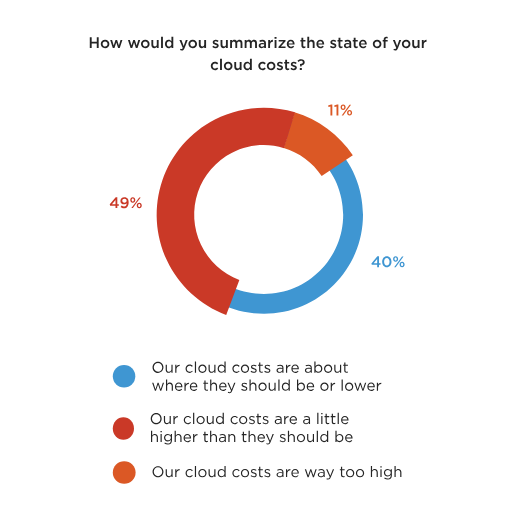
Some of the components that determine the cost of cloud services include:
- Compute: You pay according to the type, number of compute instances and duration.
- Storage: For managed storage services attached to compute instances, you pay for an entire storage volume regardless of how much you use. For elastic storage, your provider might charge you by GB-month of storage used.
- Networking: Most cloud providers bill you according to the volume of data transferred into and out of the cloud service. Providers can also apply special charges for virtualized network services.
Additionally, adopting a cloud-based infrastructure can help you save money compared to on-premises expenditure. With strategic planning and a suitable cloud cost model, you can avoid overpaying for cloud services.
Monitor cloud spending
Choosing the right cloud cost model can help you monitor your cloud spend. For example, you can opt for a reserved instance or fixed subscription model if you have stable workloads. If your systems require additional performance, you can provision more as-needed resources using spot instances.
Enable scalability and performance optimization
With a cloud infrastructure, you can get the performance you need without paying for extra features you won’t use. When sticking to a particular cloud cost model, you can scale resources as needed without overprovisioning or overspending.
Cloud cost model strategies and best practices
As you decide on the best cloud cost model for your workloads, it is important to follow common best practices. Let’s take a look!
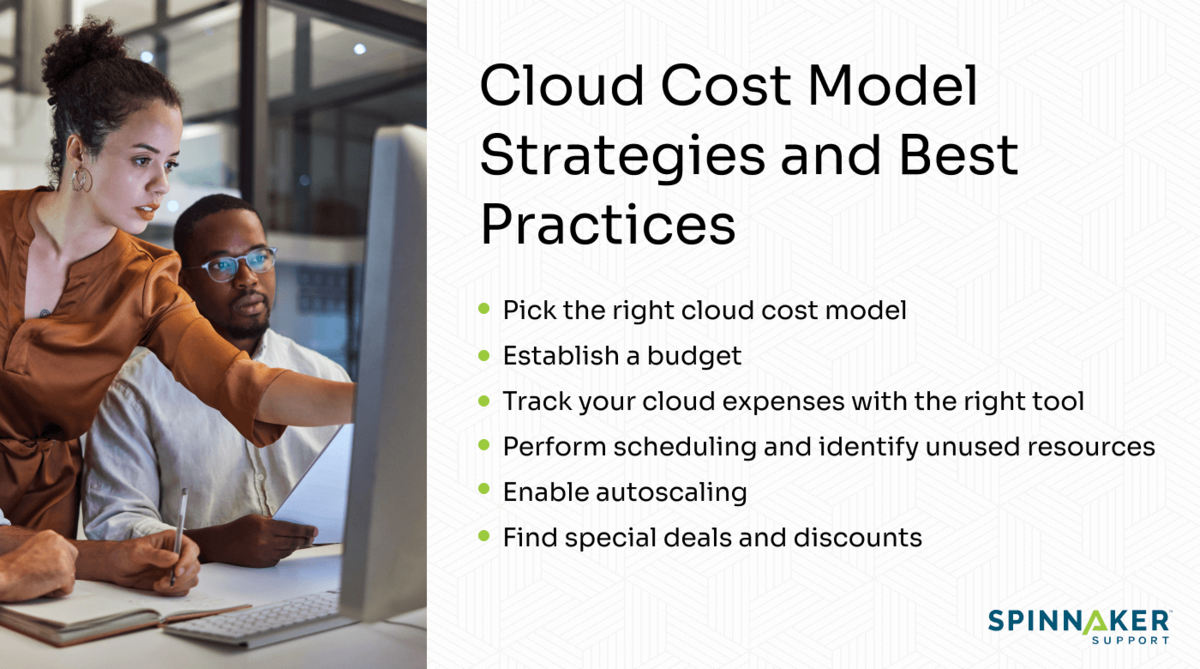
Pick the right cloud cost model
When selecting a cloud cost model, you should base your decision on key factors such as your program’s duration, the level of uptime needed, and workload requirements.
Establish a budget
You need to understand your cloud usage patterns and how many resources your workloads require. Then, establish your budget objectives and set budget limits for the specific cost models you choose.
Track your cloud expenses with the right tool
Cloud providers help organizations optimize their cloud spending by providing tools to track usage and costs. For example, with monitoring tools you can perform cloud data management, helping you track processing, storage, and data transfer expenses.
You can access specific tracking tools depending on your cloud provider. Some cloud providers provide native tools; for instance, Amazon Web Services (AWS) customers have access to the AWS Cost Explorer.
Perform scheduling and identify unused resources
You should incorporate continuous reporting to find any underutilized resources in your cloud deployment and remove them to reduce expenses.
Enable autoscaling
Another best practice is to enable autoscaling to provision resources up or down depending on usage. Autoscaling can help you reduce costs by curbing the underutilization of resources.
Find special deals and discounts
In 2024, end-user spending on public cloud services is projected to reach $678.8 billion, a 20.4% increase from $563.6 billion in 2023. With such an increase in spending, businesses that strategically plan their cloud budgets will cut back on cloud costs. You can opt for discounted pricing models that cloud services like AWS and Azure offer.
Common challenges with cloud cost models
Companies aim to save money and improve performance by moving to the cloud or adjusting their cloud strategy. However, using cloud technologies doesn’t always guarantee that they’ll get these benefits.
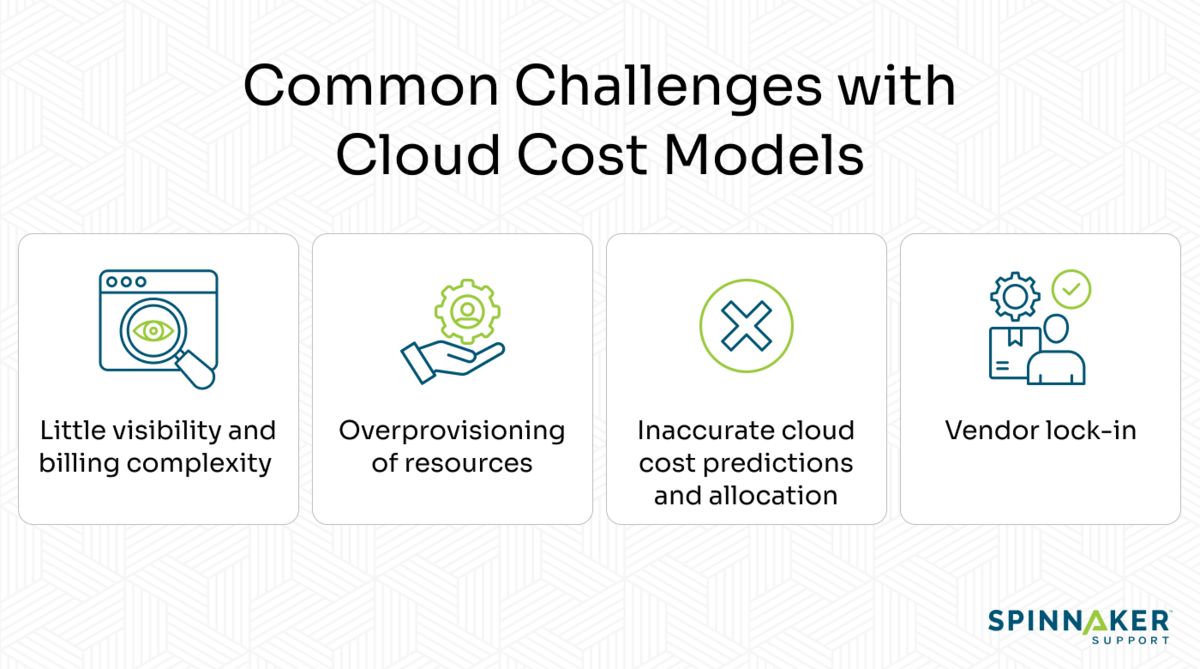
Little visibility and billing complexity
Cloud environments can be complicated, with different services and pricing models. As a result, businesses might not have an accurate and comprehensive overview of their cloud expenditures. It can be hard to figure out where the money is going when cost breakdowns are unclear.
Choosing the wrong cost model means you might also pay more for underutilized resources or during peak times. With the right cost model, you can continuously monitor your expenditure and, in turn, achieve cost savings.
Overprovisioning of resources
Overprovisioning of resources occurs when IT teams are unsure about the actual resource requirements. You may then end up reserving more compute instances when, in actual sense, you need less.
Moreover, if your company has limited cost optimization and monitoring procedures, you may lack proper controls to determine the needed resources. Ineffective utilization of resources can lead to wasted expenditure.
Inaccurate cloud cost predictions and allocation
Accurate cost prediction and allocation can be difficult without the right monitoring tools and procedures. Additionally, cloud providers may alter their pricing models, making it difficult for users to forecast future costs accurately. Hence, you might have to pay more for new features or upgrades.
Vendor lock-in
Being overly dependent on one vendor may make it more difficult to negotiate better terms or benefit from cost savings offered by other vendors. Additionally, many vendors often phase out older versions of their systems when they reach the End of Service Life. For example, SAP is pushing its customers to migrate their ERP systems to their cloud version SAP S/4HANA.
Before organizations can figure out how much it will cost to move to and adopt the cloud, they need to fully audit their current IT, including direct and indirect costs.
If companies switch to cloud technologies without guidance, they can make mistakes along the way or realize they should have stuck with on-premise infrastructure. To avoid this, your company can follow best practices for software migration or partner with a third-party support provider like Spinnaker Support.
Preparing for the future of cloud cost models
Future projections indicate that cloud adoption will continue to rise. From 2023 to 2030, the worldwide cloud computing industry is projected to expand from an initial 2022 valuation of $483.98B at a compound annual growth rate (CAGR) of 14.1%. As such, whether you are migrating your existing systems or already on the cloud, it is wise to plan strategically on cloud costs.
Further, cloud costs and expenditures are expected to rise, with more and more companies adopting and budgeting for the cloud. Thanks to its increased adoption, cloud computing is set to surpass $1 trillion in global spending by 2027.
With the advancement of technology and increased cloud adoption, companies may start to feel the pressure from first-party vendors to leave legacy systems for newer ones. Such migration incentives feature expensive solutions with costly first-party support.
Although one of the major cloud computing benefits is cost savings, initiating a lift and shift migration might require a substantial investment. Whether you are moving your entire legacy system or just performing cloud database migration, third-party support can help you plan your migration strategy.
Third-party support can help ease the frustration over cloud migration plans, costs, and security concerns by maintaining current legacy systems until they are ready to migrate. For instance, Starkey partnered with Spinnaker Support to receive continuous support for their on-premises Oracle systems throughout the migration process to the Oracle Cloud.
Additionally, a third-party provider can offer benchmarking services, which measure your cloud costs in relation to industry best practices. You can, therefore, figure out where you can save money by matching your usage patterns with optimal configurations.
Every business has unique requirements. While cloud computing offers many benefits, it may not be the right choice for your company (for now). Spinnaker Support can continue supporting legacy systems, like Oracle Database, for as long as needed so you can migrate on your own schedule. We can offer valuable insights and recommendations as you weigh your options.
Conclusion
As you continue to invest in cloud resources, finding the best pricing model will help you optimize spending and stay competitive in the marketplace. If you’re unsure how to pick the right cost model or have any other concerns about your cloud systems, you can consult a third-party support provider like Spinnaker Support for guidance.
If you’re ready to take advantage of third-party support, contact one of our support experts today.

